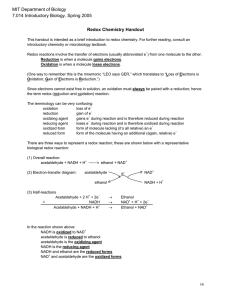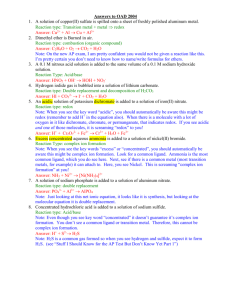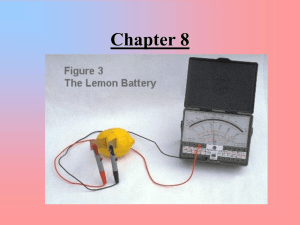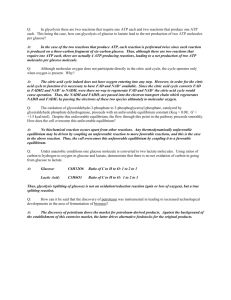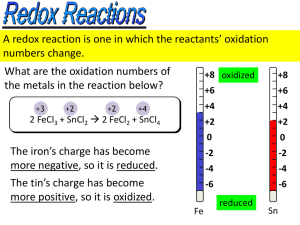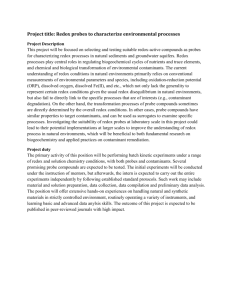Redox Chemistry Handout
advertisement
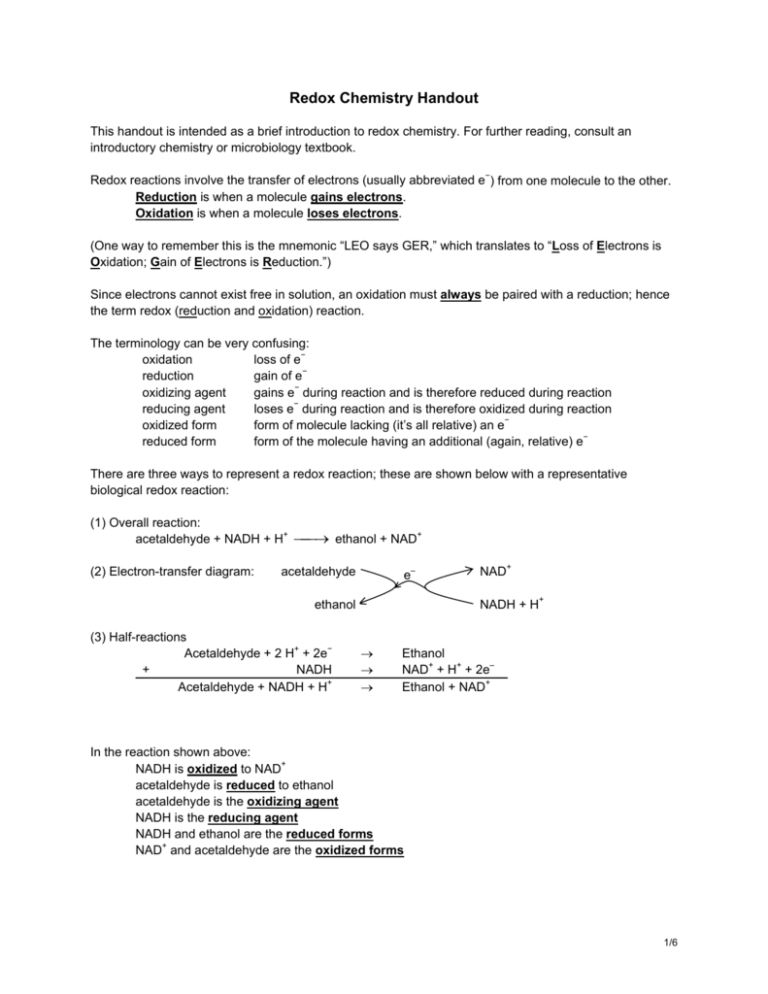
Redox Chemistry Handout This handout is intended as a brief introduction to redox chemistry. For further reading, consult an introductory chemistry or microbiology textbook. Redox reactions involve the transfer of electrons (usually abbreviated e−) from one molecule to the other. Reduction is when a molecule gains electrons. Oxidation is when a molecule loses electrons. (One way to remember this is the mnemonic “LEO says GER,” which translates to “Loss of Electrons is Oxidation; Gain of Electrons is Reduction.”) Since electrons cannot exist free in solution, an oxidation must always be paired with a reduction; hence the term redox (reduction and oxidation) reaction. The terminology can be very confusing: oxidation loss of e− reduction gain of e− oxidizing agent gains e− during reaction and is therefore reduced during reaction reducing agent loses e− during reaction and is therefore oxidized during reaction oxidized form form of molecule lacking (it’s all relative) an e− reduced form form of the molecule having an additional (again, relative) e− There are three ways to represent a redox reaction; these are shown below with a representative biological redox reaction: (1) Overall reaction: acetaldehyde + NADH + H+ ⎯ ⎯→ ethanol + NAD+ (2) Electron-transfer diagram: acetaldehyde e– NADH + H+ ethanol (3) Half-reactions Acetaldehyde + 2 H+ + 2e− + NADH Acetaldehyde + NADH + H+ NAD+ → → → Ethanol NAD+ + H+ + 2e– Ethanol + NAD+ In the reaction shown above: NADH is oxidized to NAD+ acetaldehyde is reduced to ethanol acetaldehyde is the oxidizing agent NADH is the reducing agent NADH and ethanol are the reduced forms NAD+ and acetaldehyde are the oxidized forms 1/6 There are two main ways that redox chemistry is discussed this class: 1) Given a redox reaction and the direction it proceeds, what is the e− flow (that is, which molecule is oxidized and which is reduced)? In order to solve this kind of problem, you will need to know how to tell which of the two forms of a given molecule is the reduced form and which is the oxidized form. The easiest way is to: LOOK IT UP. Use a table of standard oxidation or reduction potentials, like the one on page 6 of this handout. These show the two forms of many common molecules and the redox relationship between them. For example, take the following reaction from the citric acid cycle: succinate + FAD → fumarate + FADH2 Looking at the chart on page 6 of this handout, you’ll find two half reactions relating the compounds in this reaction: (1) fumarate + 2H+ + 2e− → succinate and (2) FAD + 2H+ + 2e− →FADH2 (Don't worry about the E° values just yet.) These two half reactions add up to the overall reaction if you reverse reaction (1): succinate → fumarate + 2H+ + 2e− + − + FAD + 2H +2e → FADH2 succinate + FAD → fumarate + FADH2 Therefore: succinate is oxidized to fumarate FAD is reduced to FADH2 FAD is the oxidizing agent succinate is the reducing agent succinate and FADH2 are the reduced forms fumarate and FAD are the oxidized forms Or, to use an electron-transfer diagram: FAD FADH2 e– fumarate succinate 2/6 2) Given a redox reaction, in which direction will it proceed spontaneously? In General: Different molecules have different tendencies to lose e–, which reflects the degree to which they are reduced. Their tendency to lose e– is reflected by their position in the chart on page 5; more reduced molecules are at the lower right of the chart. The more reduced a molecule is, the more potential energy it contains to be released for biological work. NH4+ For example: O2 e− NO2− H 2O releases energy NH4+ is reduced; it has a tendency to release e− (it is lower in the chart). O2 is very oxidized; it has a strong tendency to accept e−. Therefore, if you transfer e− from NH4+ to O2 (“up the chart”), energy will be released (∆G<0). This process can continue as e− are transferred to O2 from NO2−; this will also release energy: NH4+ O2 e− H 2O O2 e − releases energy NO2− releases energy H 2O NO3− On the other hand, the reverse reaction (transfer e– from H2O to NO2−; “down the chart”) requires energy input to run in the direction shown (∆G>0): H 2O O2 e − requires energy input NO2− NO3− This can be put in mathematical terms using the E° values on the chart. This is analogous to figuring out ∆G for a reaction to determine which direction will proceed spontaneously. In the case of redox reactions, the energy of the reaction is measured in volts; each reaction has a standard potential (voltage) E°. ∆G° and E° are related by the Nernst equation: ∆G´0 = -nF(∆E´0) Where: n = number of electrons transferred per reaction kcal F = the Faraday constant ⎛23 Volt·mol⎞ ⎝ ⎠ ∆E´0 = E´0(reducing agent) − E´0(oxidizing agent) 3/6 Note: to determine the direction of a redox reaction, you do not need to use the Nernst equation. You only need to know the sign of ∆E´0. ∆E´0< 0 reaction spontaneous ← ⎯⎯ ∆E´0> 0 reaction spontaneous ⎯ ⎯→ (note that this is the reverse of ∆G) This is shown for the previous reaction: In order to arrive at the desired overall reaction: • you must reverse the sign of E´0 for a reaction if you reverse the direction of the reaction. Here reaction (2) must be reversed. • Even though we multiplied the reactions by a constant (6 × reaction 1; 12 × reaction 2) to balance the reaction, we did not multiply E´0 even if you multiply the reaction by constant (this is not the same as ∆G). This is shown below: 6CO2 + 24H+ + 24e− + 12H2S 6CO2 + 12H2S → → → glucose + 6H2O 12S + 24H+ + 24e− glucose (C6H12O6) + 6H2O + 12S E´0 = -0.43V E´0 = +0.243V ∆ E´0 = -0.187V Since ∆ E´0< 0, the reaction is spontaneous to the left (→). This means that it requires energy input to go to the right— therefore, energy input is required get net glucose synthesis. Since this is a photosynthetic reaction, and a substantial amount of light energy is available, this is no problem. Note that, since we did not need to balance the reaction to calculate ∆E´°, we could have simplified the calculation as follows: 6CO2 + e− → glucose E´0 = -0.43V + H 2S → S + e− E´0 = +0.243V CO2 + H2S → glucose + S ∆ E´0 = -0.187V In all cases, you do not have to balance the reaction to find ∆E´°. ∆G´0 can be calculated in the following way: (Note: you will not need to do, it is only included FYI) This is where balancing the reaction comes in—you have to balance the reaction to get n, the number of e− transferred. In the case of the above reaction n = 24. ∆G´0 = -nF(∆ E´0) kcal ∆G´0 = -24⎛23 Volt·mol⎞ (-0.187V) ⎝ ⎠ ∆G´0 = +103 kcals/mol This is a highly endothermic reaction—therefore a substantial input of energy is required to get net production of glucose. Since this is a photosynthetic reaction, and a substantial amount of light energy is available, this is no problem. 4/6 Final Note: This overview of oxidation-reduction reactions has been grossly oversimplified to provide the level of understanding necessary to cover the basics of photosynthesis and respiration. In reality, you will find that all redox reactions are affected by pH and the concentrations of products and reactants. Furthermore, some products or reactants can be further stabilized by other chemical reactions (e.g. Fe3+ can precipitate as Fe(OH)3) which will also alter the equilibrium. Because of these various circumstances, you may come across situations that do not seem to make sense on the basis of standard redox potentials alone. The chart on the following page shows the tendency of various compounds to gain or lose e−. The chart on the next page shows the tendency of various compounds to gain or lose e−. 5/6 Standard Eº values (at 25° C and pH 7) Half-Reaction ⇒ 1/2 O2 + 2 H+ + 2 e− Fe3+ + e− ⇒ ⇒ NO3− + 6 H+ + 6 e− NO3− + 2 H+ + 2 e− ⇒ NO3− + 10 H+ + 8 e− ⇒ NO2− + 8 H+ + 6 e− ⇒ CH3OH + 2 H+ + 2 e− ⇒ fumarate + 2 H+ + 2 e− ⇒ 2 H + + 2 e− ⇒ oxaloacetate + 2 H+ + 2 e− ⇒ + − CH2O + 2 H + 2 e ⇒ ⇒ pyruvate + 2 H+ + 2 e− acetaldehyde + 2 H+ + 2 e− ⇒ SO42− + 8 H+ + 6 e− ⇒ 2− + − SO4 + 10 H + 8 e ⇒ ⇒ FAD + 2 H+ + 2 e− CO2 + 8 H+ + 8 e− ⇒ S + 2 H + + 2 e− ⇒ + − ⇒ N2 + 8 H + 6 e NAD+ + H+ + 2 e− ⇒ NADP+ + H+ + 2 e− ⇒ 2 H + + 2 e− ⇒ CO2 + 4 H+ + 4 e− ⇒ Fe2+ + 2 e− ⇒ H 2O Fe2+ 1/2 N2 + 3 H2O NO2− + H2O NH4+ + 3 H2O NH4+ + 2 H2O CH4 + H2O succinate H2 (pH 0) malate CH3OH lactate ethanol S + 4 H 2O H 2S + 4 H 2O FADH2 CH4 + 2 H2O H 2S 2NH4+ NADH NADPH H2 (pH 7) 1/6 glucose + H2O Fe E0 (V) 0.816 0.771 0.75 0.421 0.36 0.34 0.17 0.031 0.00 -0.166 -0.18 -0.185 -0.197 -0.20 -0.21 -0.219 -0.24 -0.243 -0.28 -0.320 -0.324 -0.414 -0.43 −-0.85 In general (these rules follow from the preceding discussion): • if electrons are transferred from compounds at the bottom of the list to compounds at the top of the list, (e− ⇑) energy is released (∆G < 0). For example, in respiration: glucose + O2 → CO2 + H2O, e− are being transferred from glucose (making CO2) to O2 (making H2O), therefore this releases a large amount of energy. • if electrons are transferred from compounds at the top of the list to compounds at the bottom of the list, (e− ⇓) energy is required (∆G > 0). For example, in photosynthesis: CO2 + H2O → glucose + O2, e− are being transferred from H2O (making O2) to CO2 (making glucose), therefore this requires a large amount of energy. 6/6
